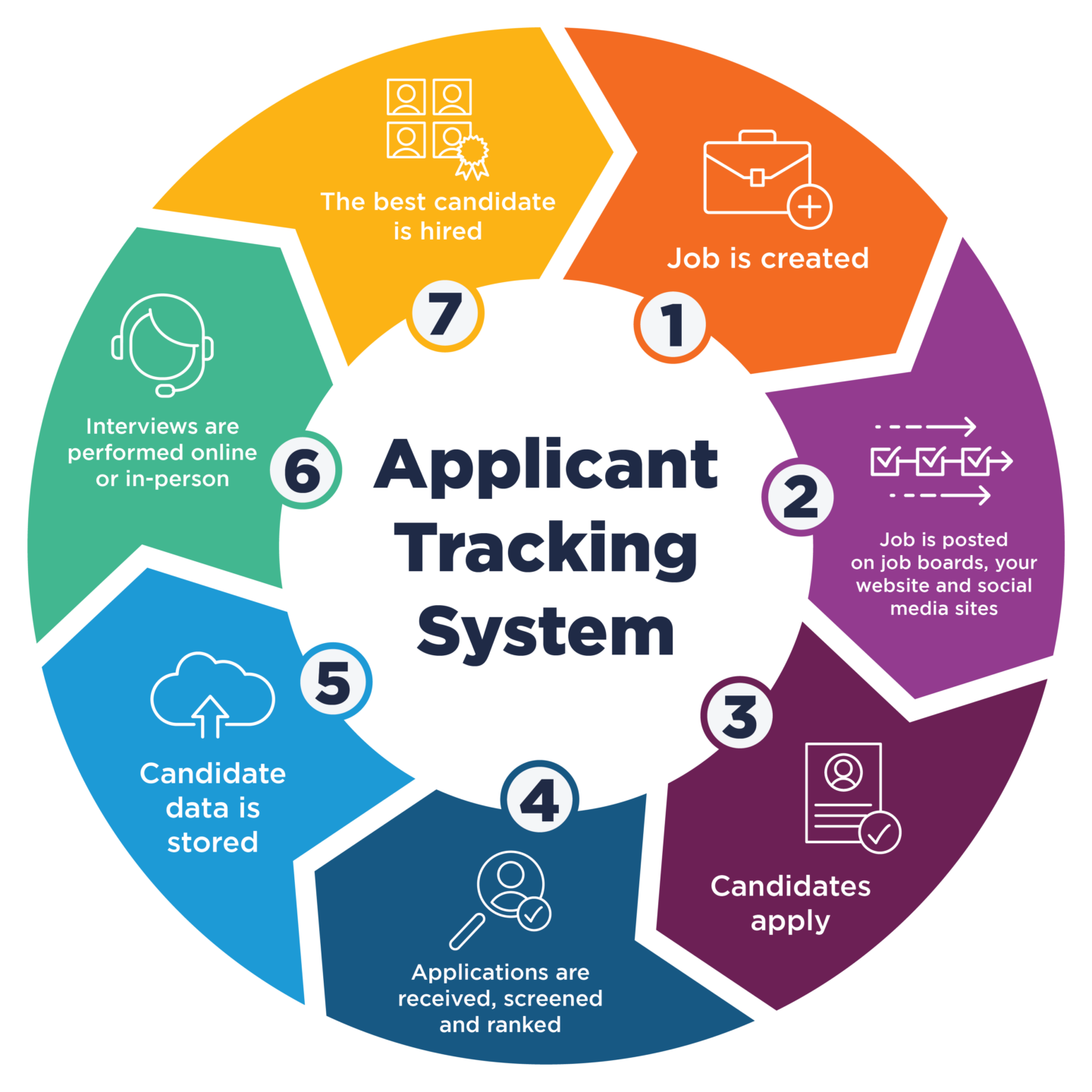What is an Applicant Tracking System (ATS)?
Recruitment agencies manage many jobs at a time and will receive a high volume of CVs for just one job advert. An applicant tracking system is a software application that helps recruitment agencies organise these CVs and candidates for hiring and recruitment purposes.
As implied in the name, an ATS tracks potential candidates through each stage in the hiring process and aims to make this easier for the recruiter whilst keeping the candidate informed of the status of their application.
An ATS also automates an agency’s recruiting operations and provides a central repository for collecting candidate information—including CVs and applications. Using automation and screening functionalities, an ATS helps recruiters narrow the applicant pool and highlights the top candidates for the job. It can do this by using artificial intelligence-type algorithms running a deep analysis of the applicant and matching this to the job description.
At its core, an ATS helps you better manage every stage in the recruiting process, from posting a job opening to collecting applications and hiring, all while delivering greater overall efficiency and streamlining your hiring process.
An application tracking system can sometimes be confused with a recruiting system. However, there is a difference. See recruiting software for a more detailed explanation.

How Do Applicant Tracking Systems Work?
Applicant Tracking System’s track your candidates’ activity, automating all stages that would otherwise require manual data entry. A good ATS will track all activity from the candidate’s CV in your inbox through final placement (and beyond), freeing up your recruiters to focus on building relationships. Because the applicant tracking system captures all of this data in real-time, you can also use it for real-time reporting and analytics to learn how to improve your processes.
There are seven main stages in the recruiting process that an Applicant Tracking System will help agencies do more efficiently (see image to the left). By bringing this process together, agencies are able to deliver a streamlined recruitment process for both their team and their candidates.
Features in an Applicant Tracking System & CRM
Each ATS is different based on the software provider, but a good ATS that can integrate with a CRM typically offers the following:
Applicant Tracking: Centralise your candidate management, jobs, and tasks streamlining the recruitment process and optimising team productivity.
Integration with Your CRM system: Break up silos between sales and recruitment and gain visibility into your customers’ changing needs with a mobile CRM purpose-built for recruitment.
Email Integration: automatically upload resumes and CVs, add notes, easily create tasks from your outlook inbox or Gmail and automatically track all emails in your ATS.
Dashboard Reporting: Transform your team’s recruitment activity into actionable business insights with configurable reports tailored to your specific goals and KPIs.
Relationship Intelligence: track all email activity associated with a particular candidate record and update that record in real-time, offering a complete view of your candidate interactions and relationships.
Candidate Engagement: Allow job seekers to easily find and apply to your open positions – then leverage mass mailing to engage with the top candidate.s.
Many ATS systems also offer the ability for agencies to connect to other Recruiting Software technologies for a complete technology solution. These technologies could include online telephony and messaging platforms, video conferencing, and many other systems, including pay and bill functionality that are used every day by recruiters.
Why Use / Why Do You Need an Applicant Tracking System?
Finding and placing the right talent is becoming more difficult in a market impacted by talent shortages. An ATS can help recruitment agencies and organisations find, hire and retain strong candidates.
A good ATS has the power to overhaul your entire recruiting operation into the most productive, profitable, and efficient business it can be. With proper implementation, they increase recruiter productivity, save time, and provide organisation and structure for your recruiting operations. Agencies that use an applicant tracking system report more placements and less unproductive time than agencies that don’t. Ninety-four per cent of recruiting professionals say their applicant tracking system has positively impacted their hiring process.
Who is using applicant tracking systems?
Most large corporations and almost all recruitment agencies use an applicant tracking system to help them with the hiring process. The job applicant won’t know that their application is managed through an ATS as they will submit their application on a job board, website or social media site; only the end user will use and see the ATS’ interface. Typically, the end user will be the recruiter who uses the system to track and manage candidates through the recruitment process. If the applicant tracking system offers reporting tools, Recruitment Managers, Directors and CEOs often use it to get an overview of the organisation’s and recruiters’ performance.
Top Benefits of an Applicant Tracking System
There are many benefits to agencies using an applicant tracking system to manage their recruitment process. This includes:
- Making faster placements and increasing margins – maximising recruiter performance with clear workflows and easily accessible information.
- With an intuitive system, recruiters can stay organised and increase the number of open jobs they place and shifts they fill.
- More placements + higher efficiency = higher margins. It’s as simple as that.
- By providing a better candidate experience, organisations can also increase retention and redeployment rate.
- Post-placement it’s especially all about the experience. A good ATS will bring all candidate information into one place, enabling recruiters to connect with a candidate at a moment’s notice or repeatedly over time to increase engagement and retention.
- Make better business decisions – manage the business with key metric reporting. Leaders can coach their staff with activity tracking, and execs can use custom reports to decide when and where to scale and expand.
How to Choose the Best Applicant Tracking System
Define the problem you’re trying to solve
It is important to fully understand what problems you are trying to solve by adopting a new ATS. Identify the major pain points you’re experiencing with your current solution and what negative effects those are having on your business outcomes. This key step will help you understand which solutions will provide the most value for your business.
Diagram your workflow
Carefully think through every step of your recruitment cycle and what capabilities you expect from your ATS in each one. In doing so, make sure to consider everyone who will be using the ATS. One solution will not likely fulfill every need perfectly but prioritise the most important things to ensure your chosen ATS can provide the features and functionality critical to your business.
Research your options
Once you know what you are looking for, speak with multiple vendors about their ATS offerings. Take advantage of free trials and demos and get quotes to price out each option. Also, make sure to get a firm understanding of the set-up and rollout process of each vendor. During your search, ask as many questions as you need and use your pre-determined feature and functionality checklist to evaluate how well each offering fits your organization’s needs.
How Much Do Applicant Tracking Systems Cost?
No recruitment agency is the same; each will need a different solution to a different problem. Most ATS providers will offer various packages based on the business’s size and complexity. See here for an overview of different ATS packages.
The Future of Applicant Tracking Systems
Applicant Tracking Systems have come a long way over the past 15 years and will keep improving and innovating. When they were first introduced to the market, they would assist with simple routine tasks. Now they’re an integral part of a recruiter’s job and can integrate with other powerful systems.
The future of applicant tracking systems will likely be about fine-tuning the existing functionalities and features. It will use more and better artificial intelligence and focus on simplifying the recruiter and candidate process. Furthermore, it will likely centre around the following:
- Improving the candidate, client and recruiter experience
- Providing a complete digital transformation of businesses where technology will take out most administrative tasks so recruiters can focus on delivering value to clients and candidates
- Seamless integration with other systems without needing multiple logins, tabs or screens. Recruitment agencies will be able to choose the tech they most want to work with and get a unified digital experience.
